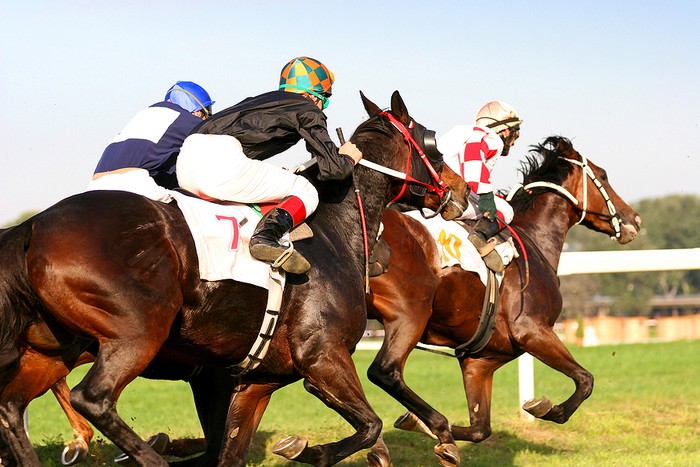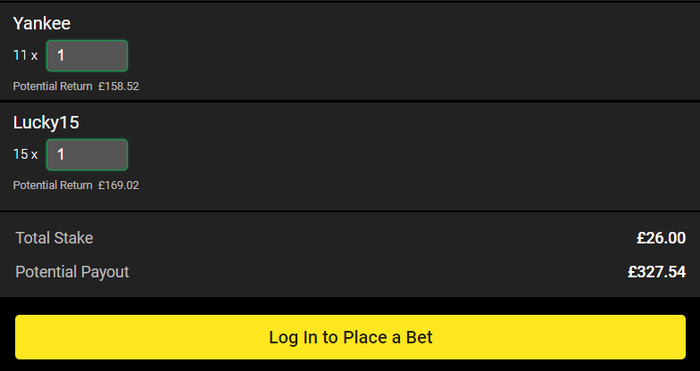 Full cover bets are a style of multiples bet that combines a number of selections into all of the various accumulators that are possible.
Full cover bets are a style of multiples bet that combines a number of selections into all of the various accumulators that are possible.
As is often the case with some of the more intricate bets available, this will be far better explained using an example, which we will come to shortly. More generally we will explain how these bets work, what sports or events they can be placed on and how the winnings are calculated. We will also detail some of the most popular full cover bets out there.
Full Cover Basics

It could be argued that you can create a full cover bet using just two selections but it is fairer and more accurate to say that the smallest full cover bet requires three selections. That being the case, let us start right there.
By selections, we mean legs, though sometimes you may see these referred to as predictions, bets, picks or another similar phrase. For the sake of argument, let’s look at a horse racing example where your three picks are the winners of the 1:40, the 2:10 and the 2:40, all at the same track. This might look something like the below, assuming all three horses are favourites and priced at odds of evens (which is written as 2.0 in decimal odds):
- 1:40 – Sir Winny @ evens
- 2:10 – Kiss My Toes @ evens
- 2:40 – What Will Be @ evens
A full cover bet takes these three selections and covers every possible accumulator. An accumulator, or acca, is a bet where two or more unrelated selections are combined and all of them must win. With three selections there are a total of four separate accas possible. These four bets are (the numbers refer to the numbers of the races/horses listed above):
- 1 and 2 double
- 1 and 3 double
- 2 and 3 double
- 1, 2 and 3 treble
Such a bet, as we will explain below, with three legs and a total of four component bets, is called a Trixie and is a popular horse racing option. With a bet like this, you need at least two of your three picks to cross the line first in order to win. In this scenario, you would win one of your four total bets, the double involving those two particular wagers. Land all three of your selections and you win all four bets, of course. It is not possible with a Trixie to win two or three of the four bets.
Note that with a full cover bet, each of the separate accas requires an individual stake. Thus, if you place a Trixie, as detailed above, a £10 bet would cost a total of £40. With some of the larger full cover bets, that feature more selections and thus more different accas, the total stake can really add up and so this is something to bear in mind. It is, of course, possible to do such bets with small unit stakes to keep the overall cost within your budget.
What Can I Place Full Cover Bets On?

Our focus here is on full cover horse racing bets but this type of wager can be made on almost any sport and market. Sticking with racing, that means you can combine a bet on a horse to win a race, a horse to place in another race (note this must be via a specific place market, not an each way bet – see below for information on full cover each way betting) and then even a special on total winning distances at a particular meeting.
Equally, you can include three races from the same meeting, or they can be from various courses that day. You can even place a full cover bet over several different days of action. One very popular pick in this regard is a Yankee (four selections, see below) based on the four Championship races of the Cheltenham Festival.
Moving away from the sport of kings, these bets can be made on any sport and are very popular for fans of football betting. You can also place a full cover bet that includes a range of different sports. Such bets are perfect for when there is a really big weekend of sport up ahead and you plan to have a very lazy one sitting in front of the TV. You might start with an over 2.5 goals bet in the early Premier League game on Saturday, follow that up with your NAP of the weekend in the big race later that afternoon, throw in a total points bet in the evening’s rugby and then finish off your four-pick Yankee with a bet on who will win the feature race on Sunday.
In short, you can place full cover bets on more or less anything, including non-sports areas like reality TV, the weather, the Oscars, or, indeed, anything else. The only real exception concerns bets that are related to each other. This is not a rule that is unique to full cover bets, nor one that varies from bookie to bookie. It should be noted that the concept of related contingencies (see next section) applies equally at all betting sites to all accas from the simplest double right the way up to a huge 10-fold.
No Related Contingencies
![]()
‘Related contingencies’ is a phrase you may have come across if you are very familiar with betting but otherwise it is likely to be meaningless. It is the bookmaking term for when two (or more) propositions, put forward as separate legs of an accumulator, cannot be combined because the likelihood of one impacts the likelihood of the other. There are all sorts of different types of related contingencies, with differing degrees of connectedness.
For example, let us imagine a dice game played with friends who are using fair odds that directly relate to the probabilities of each outcome. The possible bets might be backing an individual number at 5/1 or alternatively backing numbers 1-3, or 4-6, at odds of evens.
If one of the friends asks to make a double on number 1 being rolled at 5/1, with the second part of the double being numbers 1-3 at evens, it should be fairly obvious to most people that this would not be fair. The effective odds for such a double would be 11/1 but it would win simply if the number one was rolled, something we know has fair odds of 5/1 and a probability of one in six, or just under 17%. In essence, the odds for the number 1 alone already “include” the odds for rolling 1-3.
Related Football Bets
Above is an example of where two propositions are directly and totally related. In football, this would be like trying to place a double on your team to win both halves and to win the game. Clearly, if they win both halves, they have to win the game, so if this was placed as a double it would unfairly increase the odds without making the outcome any less likely.
There are many other examples of related contingencies where Part A happening does not automatically mean that Part B must also have happened, but where, nonetheless, the selections are clearly related. Sticking with football, you cannot place a bet on Mo Salah to score and Egypt to win as a double because clearly if Salah scores the chances of Egypt winning are greater than if he doesn’t.
Instead, this is a separate single bet called a wincast, with the odds calculated not by multiplying the odds of the two separate elements together but instead according to the bookmaker’s algorithms. A similar example from horse racing would be betting on one horse to finish first and one to finish second. This is a forecast, with its own odds, as opposed to a double.
How Will I Know if a Bet is Related?
Although it is not always the case, usually markets on the same match, event, race or other contest will be related contingencies. If you are unsure whether selections you want to combine into a full cover bet are related contingencies, checking with the bookie is the best option. If you are making your bets online then typically the system simply will not allow such picks to be combined, or you will receive an error message when you try to make the wager.
How Are My Winnings Calculated?
![]()
When you place a full cover bet with a bookmaker you may be shown the total possible return but this will only ever be based on the outcome of when all bets win. For any other winning wager, your returns depend on the odds for each of the winning doubles, trebles and so on that made up your overall bet.
If we consider our racing Trixie with all three selections priced at odds of evens, the returns would be as follows, based on a £10 unit stake costing £40 in total:
- 0 winners means no winning bets and a £40 loss
- 1 winner yields no successful bets and the same £40 loss is incurred
- 2 winners gives you one winning double and a break-even £40 return
- 3 winners sees you win all four bets for a return of £200 and net win of £160
With larger full cover bets, involving six, seven or even more selections, you will normally need a majority of your picks to win in order to see a positive return. This is because these bets involve a very high number of component bets, many of which will lose unless a large number of the individual bets win. That said, your outcome does, of course, depend on the odds.
A Super Heinz has seven selections and a massive total of 120 separate bets, meaning a £10 Super Heinz will set you back a wallet-busting £1,200! If you land just two of your seven legs, you will win just one double and lose the other 119 bets. However, if you managed to get those winners over the line at 10/1 and 14/1 you would still make a tidy return of £450. What’s more, if you had a third winner, even priced at far shorter odds of evens, that return would leap up to a huge £4,270, even though the vast majority of your 120 individual bets were losers.
Common Full Cover Bets
Full cover bets range from the aforementioned Trixie with just three selections, up to huge multiples made up of literally hundreds of separate bets. Whilst you can, in theory, construct a full cover bet with as many individual selections as a bookie will permit (usually around 14), the following are the most well-known options and the ones that have been granted the honour of having been named!
| Bet Name | Selections | Total Bets |
|---|---|---|
| Trixie | 3 | 4 |
| Yankee | 4 | 11 |
| Canadian/Super Yankee | 5 | 26 |
| Heinz | 6 | 57 |
| Super Heinz | 7 | 120 |
| Goliath | 8 | 247 |
These bets are broken down as follows:
- Trixie: 3 doubles, 1 treble
- Yankee: 6 doubles, 4 trebles, 1 fourfold
- Canadian/Super Yankee: 10 doubles, 10 trebles, 5 fourfolds, 1 fivefold
- Heinz: 15 doubles, 20 trebles, 15 fourfolds, 6 fivefolds, 1 sixfold
- Super Heinz: 21 doubles, 35 trebles, 35 fourfolds, 21 fivefolds, 7 sixfolds, 1 sevenfold
- Goliath: 28 doubles, 56 trebles, 70 fourfolds, 56 fivefolds, 28 sixfolds, 8 sevenfolds, 1 eightfold
Most punters tend to opt for the smaller options, with Trixies and Yankees proving very popular with racing fans. However, at the same time, there are a significant number of betting fans who love placing the larger bets, perhaps using very small unit stakes to allow for the fact that you are covering 120 or even 247 separate bets.
The winnings really can add up with these bets, as we shall demonstrate shortly when we look at some of the huge hauls some lucky, brave or skilful punters have landed over the years. Hypothetically though, let us consider a Goliath where you managed to pick seven winners at odds of 6/1, 2/1, 10/1, evens, 20/1, 4/1 and 7/1. Had you staked just 10p per bet, costing under £25 in total, your returns would be a massive £136,827!
Backing Full Cover Bets Each Way

Of course, landing one winner at the track is far from easy, let alone managing four, five, six or more. At the same time, getting a winning favourite at evens is no mean feat, but finding winners at 10/1 or 20/1 is certainly incredibly difficult. For this reason, each way betting is popular when it comes to betting on the horses and it can also be used for full cover bets.
An each way Yankee (or any other full cover bet) works in exactly the same way as an each way single in that you have two separate stakes, one on the win and one on the place. That means that a £5 each way Yankee will cost £110, essentially a £5 each way bet on all of the 11 component wagers.
All four selections are picked each way and all of your doubles, trebles and fourfolds are backed both to win and to place. You cannot pick some selections to win and some each way, however the percentage of the odds (for example a quarter or a fifth or whatever else) and the number of places relevant (be it two, three or four) are specific to the conditions of each race.
To win any of your included accas, all of the relevant legs must win for the win bet, and all must either win or place for the place part of the bet. So with an each way Yankee where two horses lose (finishes outside of the places), one horse wins and the other finishes second, your only winning bet is one single each way double. Any of the 11 bets within a Yankee that include a selection that does not even place automatically loses and, as ever, to win all 11 win and place bets you need your four picks all to win.
Each way full cover bets are great when you fancy taking favourites on and suspect there may be an outsider who can at least nick a place and possibly even win. They offer you a little insurance as compared to a win Yankee but, of course, your stake is doubled. In terms of maintaining your interest and excitement in the races, this type of bet is also great as even if your horse isn’t fighting for the lead, they may still have an excellent chance of keeping your bets live by landing a place.
Full Cover With Singles
Now we have looked in great depth at the various important aspects of full cover betting it is well worth looking at a very similar type of wager: the full cover with singles. The “full cover” description of the bets above may be deemed to be misleading by some because there is one obvious bet that is missed, each of the single legs that form the overall bet. As said though, the full cover refers to the fact that all of the possible accas are covered and if you want to back the singles as well, you should be opting for one of the “full cover with singles” options below.
| Bet Name | Selections | Total Bets |
|---|---|---|
| Patent | 3 | 7 |
| Lucky 15 | 4 | 15 |
| Lucky 31 | 5 | 31 |
| Lucky 63 | 6 | 63 |
| “Lucky 127” | 7 | 127 |
These bets are identical to the first ones we looked at but in each case you also have additional wagers on each of the legs as standalone singles. With a full cover bet you need at least two selections to win to land any return but with these, just one will bag you a winner and at least see some of your cash returned from the bookie. Though winning just one single is generally very unlikely to cover your initial stake.
The Lucky 15 is said to have been invented by Fred Done, the founder and figurehead of Betfred. It is probably the most popular of the full cover with singles wagers and is much-loved by many racing fans. Whether Betfred did create the bet or not, it is now offered by all bookies, as are the larger iterations, and the smaller Patent bet. A “Lucky” bet with more than six selections does not really exist as a named wager but that does not stop you from placing a “Lucky 127” or even a “Lucky 255”, the latter involving eight legs.
One big advantage of including the singles is that some bookies have offers that can make your wins much bigger and can even turn a seemingly poor bet into a winning one. The two most common offers see a boost to winnings when you get all selections right, typically ranging from 25% to 100% (the larger rewards being for bigger bets with more legs); and a boost to your odds if you only manage to get one winner, usually offering triple the odds on a Lucky 15, four times the odds on a Lucky 31 and five times the odds on a Lucky 63. If you are a fan of this style of betting it is certainly well worth looking for a betting site that has at least one of these promotions or something similar.
How To Place These Bets

If you want to place any one of the many bets that we have looked at it really is very simple if you are betting with an online bookie. The first step is to add the individual selections to your betting slip. Once you have the three, four, or more legs added, head to the slip and you should be presented with a range of options.
Exactly what these will be will vary depending on how many selections you have added and which site you are using. Many bookies will directly offer most of the bets we have listed and usually in brackets alongside the bet name, be that Yankee, Lucky 15, Goliath, or whatever, will be the number of individual wagers involved. For example, you might see “Lucky 31 (31)”.
Just pick whichever bet you want to go for and then enter the stake in the relevant box, noting that whatever you put here will be multiplied by the number of doubles, trebles and so on your larger multiple includes. The total stake will be shown at the bottom of the slip, such that if you enter £1 alongside the Lucky 31 box you will get a total stake of £31.
Next, you just need to make sure you confirm the bet in the same way you would normally, clicking whatever buttons are needed to make sure the bet is fully confirmed and placed. If you do not see the type of bet you want to make listed on the slip, it may be possible to effectively create your own full cover, or full cover with singles wager manually.
Some Huge Winners

If you’ve been betting long enough you will have landed one big win for yourself or at least know somebody who has but there is a difference between a big win and a really big win. As we have seen, full cover bets can yield some huge returns if you have enough winners at decent odds and over the years there have been many massive winners placing these sorts of wagers. Here we take a look at some of the biggest and most interesting wins of the last few years.
£205k But Almost £1.7m
As recently as March 2021 a punter managed an incredible Goliath that came oh so close to scooping him £1.7m! His racing bet cost a total of just £24.70, with 10p for each of the 247 bets that make up a Goliath.
His winners came in at 15/2, 6/1, 8/1, 7/1, 11/2 (twice) and 10/3 with just one of his eight picks letting him down. Scooping over £200k is clearly an incredible achievement but had Tommy’s Oscar managed to win at 13/2 (it came sixth) he would have won an insane £1,744,194 Oh, and 17p.
Tiny Stakes Transformed Into £95k
If 10p per bet is a bit too much for your bank to handle (and to be fair, with 247 bets to cover it could well be), how about making a 2p each way bet and ending up with almost 100 grand? Back in 2014 Clive Wallace landed an incredible life-changing Goliath when seven of his eight picks won. Things got off to an inauspicious start for the 49 year old tiler when his first bet, Lilac Tree lost. That was arguably his banker too at 15/8 but then winners at odds as big as 18/1, 12/1 and 8/1 resulted in his massive payday. Not bad from a bet that cost just £9.88 in total and started with a loss!
Lucky 31 = Lucky £58,336
In 2018 a man managed to turn a £1 Lucky 31 (total cost £31) into just under £60,000 when he landed five out of five winners. The 62 year old bagged his fortune betting at York, thanks to winners at 15/2, 3/1, 7/1, 12/1 and 9/2. He would have “only” won around £38,000 but bagged a 50% bonus with Betfred thanks to getting all five of his picks right.
Luck Of The Irish Worth More Than €355k
A Dublin punter landed well over €350k thanks to a brilliant each way Super Heinz bet (seven selections, 120 bets in total). In 2017 he got six winners from his seven picks, scooping the incredible win with horses coming in at between 10/3 and 14/1. Amazingly his first six horses all won but Imperial Way let him down, denying him what would have been a million Euro plus payout.
